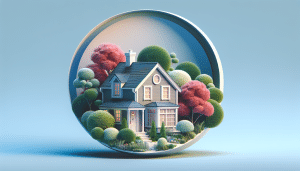You Could Unlock Equity with Home Renovation Trends
Megan Gray August 29, 2025
Are you wondering how certain home renovation trends might impact the value of your property? This guide explores the influence of modern updates, equity-building strategies, refinancing, and sustainable improvements. Discover what shapes the real estate market and learn how homeowners align projects with market shifts for long-term value.
Home Renovation Trends That May Boost Property Value
Smart home renovation choices can result in increased property value and stronger equity growth. Trends like kitchen remodeling, energy-efficient upgrades, and open floor plans have shown lasting appeal. When homeowners focus on updates with proven returns, properties often stand out in a competitive market. Embracing emerging real estate trends, such as multipurpose spaces and enhanced curb appeal, allows for adaptability that appeals to various buyer types. A well-designed layout paired with energy-smart choices can create an inviting environment while making future resale more attractive. Kitchen and bathroom updates, in particular, are frequently associated with a notable spike in home equity for many property owners, benefiting both present comfort and long-term value. (Source: https://www.nahb.org/-/media/NAHB/news-and-economics/housing-economics/housing-economics-plus/special-studies/2022/special-study-home-remodeling-february-2022.pdf)
Renovation trends are increasingly influenced by sustainability and efficiency. For example, installing solar panels, low-flow plumbing, and insulated windows aligns with green building principles that are resonating with buyers and appraisers. Many communities now incentivize sustainable improvements, sometimes offering rebates or faster permitting. These integrated practices signal to prospective buyers a commitment to lower utility costs and overall responsible living. This can be particularly beneficial in regions where energy efficiency is valued both economically and culturally. Research shows that homes with sustainable renovations often enjoy stronger appreciation over time and a more resilient resale profile. (Source: https://www.energy.gov/energysaver/energy-efficient-home-design)
Another trend reshaping renovation strategies is the inclusion of flexible and tech-enabled living spaces. Work-from-home setups, high-speed network wiring, and spaces adaptable for multi-generational families have surged in demand. Real estate professionals note that homes ready for these shifts fetch greater interest and may even command higher appraisal values. This adaptability is especially important in fast-changing markets where buyer priorities fluctuate rapidly. Open layouts, movable walls, and dedicated office spaces all reflect the modern demand for flexibility, making properties more appealing to a wider audience. The strong interplay between renovation trends and property value positions informed homeowners to capitalize on shifting priorities. (Source: https://www.nar.realtor/research-and-statistics/quick-real-estate-statistics)
Understanding How Renovations Influence Home Equity
Home equity represents the portion of a property’s value that exceeds the balance owed on the mortgage. Renovations are one strategic way to build this equity, especially when updates are targeted to high-impact areas. Upgraded kitchens, improved energy efficiency, or adding a bathroom are classic projects known to deliver substantial returns upon home valuation. When executed with careful planning and budget discipline, these improvements can outpace market appreciation and improve financial security for homeowners. Having a concrete understanding of how lenders and appraisers measure value increases is critical to maximizing these gains. Successful renovations help ensure more of each mortgage payment directly enhances personal wealth through increased equity. (Source: https://www.huduser.gov/portal/publications/pdf/NRAPaper-Homeownership.pdf)
It’s important to recognize that not all improvements yield the same return on investment. While broad upgrades like landscaping and curb appeal projects offer a strong first impression, targeted interior upgrades—such as flooring, lighting, and bathroom fixtures—can generate better appraised values. This difference in return is often due to market preferences, region-specific trends, and overall neighborhood standards. Homeowners who research which renovations matter most locally can optimize their spending for the greatest impact. Consulting with local real estate professionals or reviewing comparable market analyses is a prudent step before committing to large-scale updates. (Source: https://www.urban.org/sites/default/files/publication/101365/home-remodeling-impact-report-2019.pdf)
Equity growth through renovation can also provide new financing options. For example, increasing equity could allow access to home equity lines of credit, refinancing, or even leveraging properties for future investments. These financial tools enable homeowners to reinvest in their property or diversify their asset portfolio. However, care should be taken to avoid over-improvement—investing well above what the neighborhood can support in resale value. By understanding local property values, long-term market shifts, and the importance of balance, homeowners can ensure renovations truly contribute to sustainable equity growth. (Source: https://www.federalreserve.gov/publications/2022-economic-well-being-of-us-households-in-2021-homeownership-and-housing-stability.htm)
Refinancing Strategies after Major Updates
Major renovations can set the stage for refinancing, potentially allowing homeowners to secure better loan terms or access cash from the increased equity. The refinancing process typically involves a home appraisal, so substantial improvements—such as renovating a kitchen, adding living space, or upgrading systems—can help properties qualify for more favorable rates. By timing renovations and refinancing thoughtfully, some homeowners position themselves to lower monthly payments or use extracted funds for additional updates or even investments. This approach, when guided by expert advice, can convert home equity into powerful financial leverage for future goals. (Source: https://www.consumerfinance.gov/about-us/blog/thinking-refinancing-your-mortgage-here-are-six-things-consider/)
Before refinancing, it’s important to evaluate closing costs and establish realistic expectations about potential savings. Lenders review current market trends, property condition, and debt-to-income ratios, all of which can shift after sizeable renovations. Upgrades that are well-documented and aligned with buyer preferences may convince appraisers to recognize higher property values, supporting more advantageous loan terms. Reviewing offers from multiple financial institutions can help identify the most favorable refinancing strategy, ensuring that the new mortgage structure reflects the true value of the renovated property. (Source: https://files.consumerfinance.gov/f/documents/cfpb_refinance-checklist.pdf)
Long-term financial planning is crucial when using renovation equity for refinancing. Consider factors like interest rate trends, local property taxes, and future market projections. For some, a cash-out refinance offers an opportunity to fund additional projects or consolidate debt, but this should always be weighed against future risks. Working with housing counselors or financial advisors can provide insights into tax implications, timing, and options based on unique household needs. Ultimately, leveraging equity through thoughtful refinance strategies supports both short-term improvements and lasting financial resilience. (Source: https://www.hud.gov/counseling)
Spotlight on Sustainable Housing and Its Market Appeal
Sustainable housing improvements continue to gain ground as a major force in real estate. Solar energy installations, high-performance HVAC units, and water-conserving landscaping are only a few examples of features that raise a property’s environmental profile. These updates not only align with climate-conscious living but can also reduce long-term ownership costs. Buyers are increasingly interested in homes that offer a blend of comfort and resource efficiency, prompting many real estate agents to highlight sustainable upgrades as a unique selling point. (Source: https://www.epa.gov/greenhomes)
Market demand for sustainable features is reflected in national surveys and property transaction trends. Homes with certifications such as ENERGY STAR or LEED often command higher prices or sell faster than comparable properties without these credentials. Neighborhoods with robust recycling, public transport options, and walkability further boost the appeal of eco-friendly homes. With sustainability now embedded in appraisals, these attributes play an increasing role in determining which listings attract competitive offers. By monitoring trends and regional preferences, homeowners can tailor improvements to match evolving buyer priorities. (Source: https://www.usgbc.org/articles/value-green-home-appraisals)
For those planning renovations, integrating eco-conscious features need not come at the expense of style or budget. Many contemporary options—such as LED lighting, responsibly sourced flooring, and drought-tolerant gardens—offer both immediate savings and long-term appreciation. Combining these elements with classic high-value renovations, like updated kitchens and bathrooms, maximizes a home’s attractiveness while supporting sustainability. The connection between environmental responsibility and property value is likely to remain a dominant theme for many real estate professionals and homeowners in years ahead. (Source: https://www.nrel.gov/docs/fy19osti/72186.pdf)
Decoding Real Estate Market Shifts and Buyer Priorities
Real estate market trends are shaped by shifts in demographics, technology, and economy, and these changes in turn influence which renovations deliver the greatest value. Millennial and Generation Z buyers often prioritize smart home technology, energy efficiency, and flexible spaces. Baby Boomers may look for accessibility features and functional designs. Understanding who is most likely to buy in a particular region can influence which projects homeowners choose to pursue. Research from leading housing agencies regularly highlights these changing priorities and their impact on home sales and values. (Source: https://www.fanniemae.com/research-and-insights/perspectives/generational-homebuying-trends)
Economic factors, like interest rate shifts or job growth, influence what buyers can afford and what features stand out. In times of economic expansion, more buyers might compete for move-in-ready homes with upgraded amenities, pushing prices higher. During slower cycles, properties that require renovation may offer stronger value for those willing to invest sweat equity. Tracking these cycles and aligning renovations accordingly allows property owners to maximize their return and meet the needs of active buyers. Reliable, data-driven approaches put sellers in the best possible position when listing. (Source: https://www.huduser.gov/portal/pdredge/pdr-edge-frm-asst-sec-020622.html)
Informed buyers increasingly use online platforms to compare properties and renovation features before setting foot in a home. Digital listing tools enable them to filter for specific amenities, sustainability certifications, and smart technologies. By recognizing and integrating features that appear frequently in online searches, homeowners and agents can appeal directly to current buyer interests. This expanded access to information underscores the importance of understanding how market shifts and priorities affect the desirability and ultimate value of any home upgrade.
References
1. National Association of Home Builders. (2022). Special Study: Home Remodeling. Retrieved from https://www.nahb.org/-/media/NAHB/news-and-economics/housing-economics/housing-economics-plus/special-studies/2022/special-study-home-remodeling-february-2022.pdf
2. U.S. Department of Energy. (n.d.). Energy Efficient Home Design. Retrieved from https://www.energy.gov/energysaver/energy-efficient-home-design
3. National Association of Realtors. (n.d.). Quick Real Estate Statistics. Retrieved from https://www.nar.realtor/research-and-statistics/quick-real-estate-statistics
4. U.S. Department of Housing and Urban Development. (2021). Homeownership and Housing Stability. Retrieved from https://www.huduser.gov/portal/publications/pdf/NRAPaper-Homeownership.pdf
5. U.S. Department of Energy. (2019). Translating Green Home Value. Retrieved from https://www.nrel.gov/docs/fy19osti/72186.pdf
6. Consumer Financial Protection Bureau. (n.d.). Thinking about refinancing your mortgage? Here are six things to consider. Retrieved from https://www.consumerfinance.gov/about-us/blog/thinking-refinancing-your-mortgage-here-are-six-things-consider/








